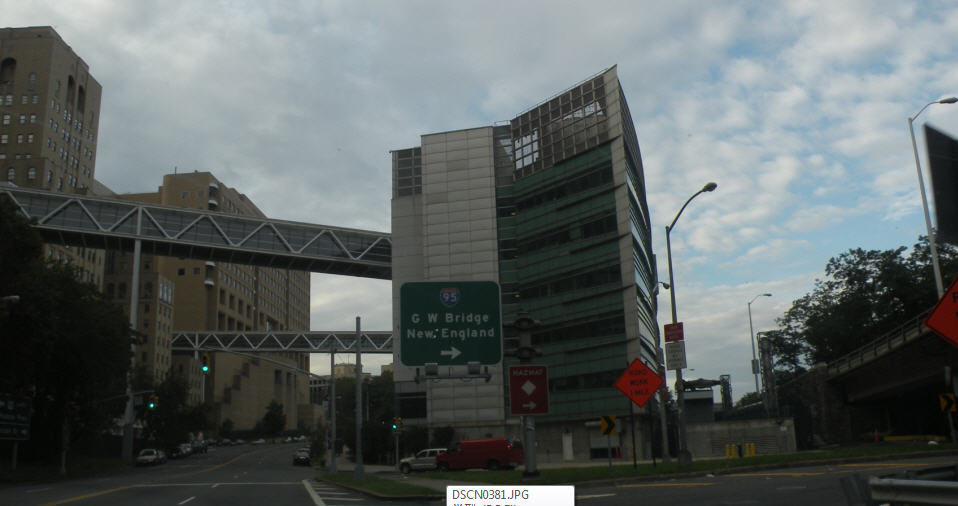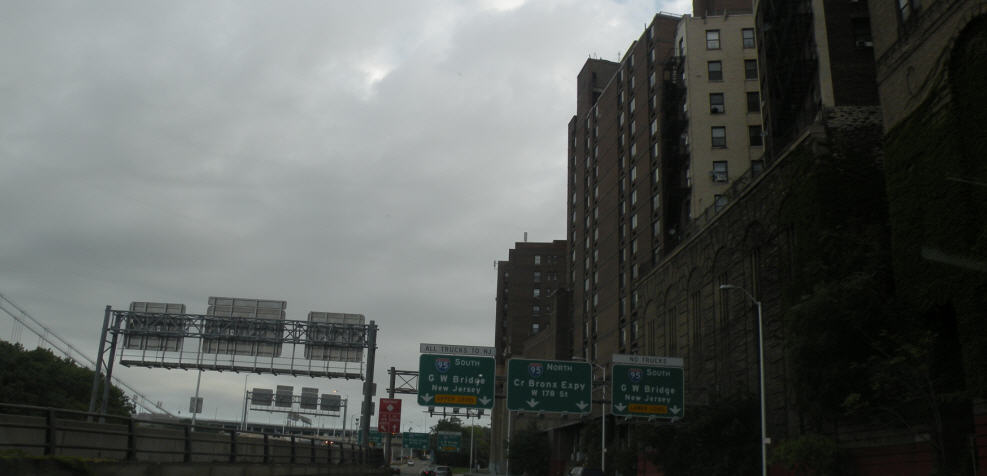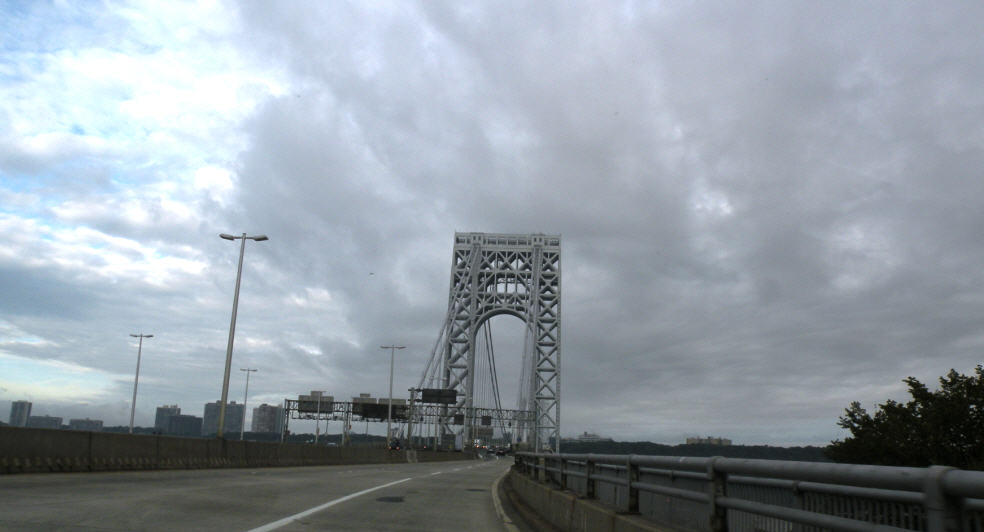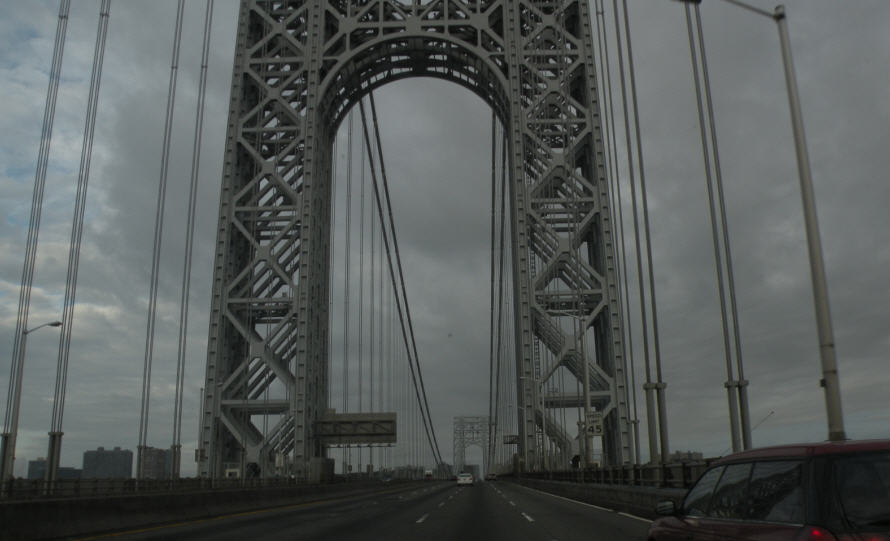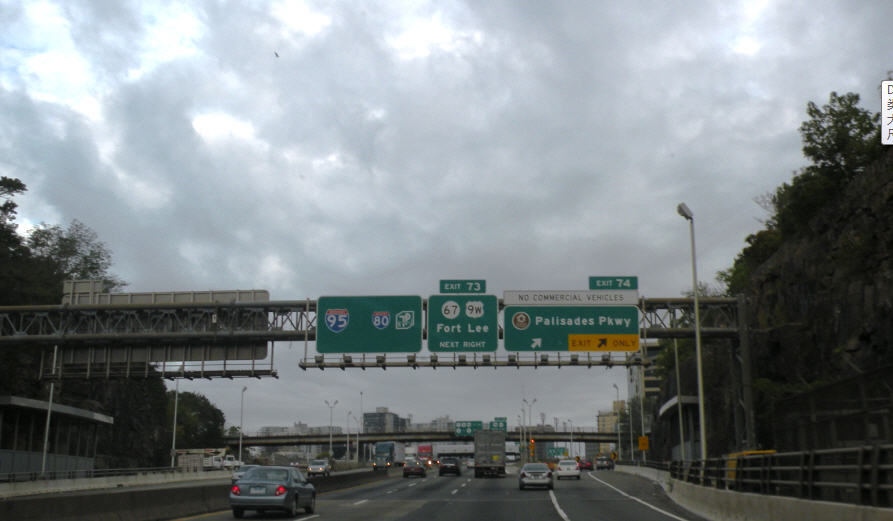博文
有感于跨越George Washington Bridge
|||
有感于跨越George Washington Bridge
黄安年文 黄安年的博客/2011年9月27日(美东时间)发布
我们所住的Danbury, CT位于新英格兰地区的西南端,由Danbury,前往新泽西经由纽约需要跨越Hudson River , 连接纽约曼哈顿地区和新泽西的有两条隧道(哈德逊河底下的林肯隧道 ,每日有120000辆车往来于曼哈顿及新泽西之间,为世界上最繁忙的行车隧道。1927年荷兰隧道落成于哈德逊河下,则是世界上第一座采用通风系统的行车隧道。)
而乔治·华盛顿大桥是哈德逊河上第一大桥。桥梁及隧道对于民众往来曼哈顿及新泽西间有着巨大的影响, 一方面方面往来, 另一方面在每逢上下班尖峰时刻,桥梁和隧道反而变成了交通瓶颈。因为在我们25日前往新泽西访友是需要选择一早出门, 下午早些返回, 以避开高峰臃堵高峰。
25日, 7:05AM我们一家六口,驱车离开Reidgebury Hills,Danbury住地,走684公路5号出口,沿着Saw Mail River Pkwy转87号公路到达Yonkers,进入纽约市246St不久顺利跨越华盛顿大桥, 时才8:10AM, 仅仅用了65分钟时间。而下午4:20PM自Plainsboro, NJ返回, 虽然在华盛顿大桥有所滞留但是也算顺利, 排队过交费站需要等待,车过大桥5:35PM, 6:45PM回到了家。
过往华盛顿大桥在20世纪90年代感觉很顺利。“9·11”以来, 这座大桥成为恐怖主义袭击和政府防范的重要目标,今年“9·11”前后,这里的检查极其严格, 所以我们避开了那一天去凑热闹,而选择25日千万新泽西访友, 我们避开了“9·11”, 却没想到自9月18日后每辆小汽车的过桥费涨到了12美元。
照片11张是即时拍摄的。
******************************
|
From Wikipedia, the free encyclopedia
George Washington Bridge | |
|
Other name(s) |
The GWB, The GW, & The George |
|
Carries |
14 lanes (8 upper deck, 6 lower deck) of I-95 / US 1 / US 9 (entire span) / US 46 (NJ side), pedestrians and bicycles |
|
Crosses |
|
|
Locale |
Connecting Fort Lee in Bergen County, New Jersey and Washington Heights, Manhattan in New York City |
|
Maintained by |
|
|
Designer |
|
|
Design |
Double-decked Suspension bridge |
|
Material |
|
|
Total length |
4,760 ft (1,450 m)[1] |
|
Width |
119 ft (36 m)[1] |
|
Height |
604 ft (184 m)[1] |
|
Longest span |
3,500 ft (1,100 m)[2] |
|
Vertical clearance |
14 ft (4.3 m) (upper level), 13.5 ft (4.1 m) (lower level) |
|
Clearance below |
212 ft (65 m) at mid-span[1] |
|
Construction begin |
October 1927 |
|
Opened |
October 24, 1931 (1931-10-24) (upper level) |
|
Toll |
Eastbound only. Cars ($12 for cash, $9.50 peak with E-ZPass, $7.50 off-peak with E-ZPass); |
|
289,329 (2008)[3] | |
|
40°51′06″N 73°57′09″W / 40.851589°N 73.952483°W / 40.851589; -73.952483 (George Washington Bridge)Coordinates: 40°51′06″N 73°57′09″W / 40.851589°N 73.952483°W / 40.851589; -73.952483 (George Washington Bridge) | |
|
| |
The George Washington Bridge (known informally as the GW Bridge,[4] the GWB,[5] the GW,[6] or the George[not in citation given]) is a suspension bridge spanning the Hudson River, connecting the Washington Heights neighborhood in the borough of Manhattan in New York City to Fort Lee, Bergen County, New Jersey. Interstate 95 and U.S. Route 1/9 cross the river via the bridge. U.S. Route 46, which is entirely in New Jersey, ends halfway across the bridge at the state border.
The bridge has an upper level with four lanes in each direction and a lower level with three lanes in each direction, for a total of 14 lanes of travel. The speed limit on the bridge is 45 mph (70 km/h), though congestion often slows traffic, especially during the morning and evening rush hours. A path on each side of the bridge's upper level carries pedestrian and bicycle traffic. As of 2007, the George Washington Bridge has the greatest vehicular capacity of any bridge in the world,[7][8] carrying approximately 106 million vehicles per year, making it the world's busiest motor vehicle bridge, according to the Port Authority of New York and New Jersey - the bi-state government agency that owns and operates several area bridges, tunnels, and airports.[9]
| Contents
[hide] · 3 Tolls |
Groundbreaking for the new bridge began in October 1927, a project of the Port of New York Authority.[10] Its chief engineer was Othmar Ammann, with Cass Gilbert as architect. The bridge was dedicated on October 24, 1931, and opened to traffic the following day.[11][12] Initially named the "Hudson River Bridge," the bridge is named in honor of George Washington, the first President of the United States.[13] The Bridge is near the sites of Fort Washington (in New York) and Fort Lee (in New Jersey), which were fortified positions used by General Washington and his American forces in his unsuccessful attempt to deter the British occupation of New York City in 1776 during the American Revolutionary War. Washington evacuated Manhattan by crossing between the two forts. In 1910 the Washington Chapter of the Daughters of the American Revolution erected a stone monument to the Battle of Fort Washington. The monument is located about 100 yards (91 m) northeast of the Little Red Lighthouse, up the hill towards the eastern bridge anchorage.[14]
USS Nautilus passes under the George Washington Bridge in 1956, when the bridge only had a single deck.
When it opened in 1931, the bridge surpassed the Ambassador Bridge for the longest main span in the world. At 3,500 feet (1,100 m), it nearly doubled the previous record of 1,850 feet (560 m). It held this title until the opening of the Golden Gate Bridge.[2] The total length of the bridge is 4,760 feet (1,450 m).[1]
As originally built, the bridge offered six lanes of traffic, but in 1946, two additional lanes were provided on what is now the upper level.[10] A second, lower deck, which had been anticipated in Ammann's original plans, was ordered by Lt Col Joseph R McCammon, US Army Corps of Engineers, opening to the public on August 29, 1962.[15] This lower level has been waggishly nicknamed "Martha".[16] The additional deck increased the capacity of the bridge by 75 percent, making the George Washington Bridge the world's only 14-lane suspension bridge, providing eight lanes on the upper level and six on the lower deck.
The original design for the towers of the bridge called for them to be encased in concrete and granite. However, because of cost considerations during the Great Depression and favorable aesthetic critiques of the bare steel towers, this was never done. The exposed steel towers, with their distinctive criss-crossed bracing, have become one of the bridge's most identifiable characteristics. Le Corbusier (Charles-Edouard Jeanneret) said of the unadorned steel structure:
"The George Washington Bridge over the Hudson is the most beautiful bridge in the world. Made of cables and steel beams, it gleams in the sky like a reversed arch. It is blessed. It is the only seat of grace in the disordered city. It is painted an aluminum color and, between water and sky, you see nothing but the bent cord supported by two steel towers. When your car moves up the ramp the two towers rise so high that it brings you happiness; their structure is so pure, so resolute, so regular that here, finally, steel architecture seems to laugh. The car reaches an unexpectedly wide apron; the second tower is very far away; innumerable vertical cables, gleaming against the sky, are suspended from the magisterial curve which swings down and then up. The rose-colored towers of New York appear, a vision whose harshness is mitigated by distance." (When the Cathedrals were White[17])
The George Washington Bridge was designated as a National Historic Civil Engineering Landmark by the American Society of Civil Engineers on October 24, 1981, the fiftieth anniversary of the bridge's dedication ceremony.[2]
Following the September 11th attacks on New York and Washington, the Port Authority prohibited people from taking photographs on the premises of the bridge because of the fear that terrorist groups might study any potential photographs in order to plot a terrorist attack on the bridge. Such prohibitions have since been lifted. As the enclosed lower level is more vulnerable to hazardous material (HAZMAT) incidents than the upper level, most HAZMATs have been prohibited there even before the September 11th attacks.[18] If weather allows, on Martin Luther King, Jr. Day, Presidents' Day, Memorial Day, Flag Day, Independence Day, Labor Day, Columbus Day, and Veterans Day, as well as on dates honoring those lost in the September 11, 2001 attacks, the bridge sports the largest free-flying American flag in the world; 90 feet (27 m) long and 60 feet (18 m) wide, the flag weighs 450 pounds (200 kg).[19][20]
[edit] Road connectionsFrom Morningside Heights.
GW Bridge, circa 1985
|
This article needs additional citations for verification. Please help improve this article by adding citations to reliable sources. Unsourced material may be challenged and removed. (August 2010) |
The George Washington Bridge carries I-95, US-1, and US-9 between New Jersey and New York. US-46 terminates at the state border in the middle of the bridge. I-80 and NJ-4 also feed into the bridge but end before reaching it. On the New Jersey side of the bridge, the Palisades Interstate Parkway connects directly to the bridge's upper level (plans to give direct access to the lower level from the parkway have been postponed), and the New Jersey Turnpike connects to both levels of the bridge. The marginal roads and local streets above the highways are known as GWB Plaza.[citation needed]
On the New York side, the twelve-lane Trans-Manhattan Expressway heads east across the narrow neck of upper Manhattan, from the bridge to the Harlem River, providing access from both decks to 178th Street, the Henry Hudson Parkway and Riverside Drive on the West Side of Manhattan, and to Amsterdam Avenue and the Harlem River Drive on the East Side. The Expressway connects directly with the Alexander Hamilton Bridge, which spans the Harlem River as part of the Cross-Bronx Expressway (I-95), providing access to the Major Deegan Expressway (I-87). Heading towards New Jersey, local access to the Bridge is available from 179th Street. There are also ramps connecting the bridge to the George Washington Bridge Bus Terminal, a commuter bus terminal with direct access to the New York City Subway at the 175th Street (A train) station on the IND Eighth Avenue Line.[citation needed]
[edit] TollsNew York side of the bridge, under restoration, as seen from the Hudson River, July 2005. Note the "Little Red Lighthouse".
GW Bridge from New Jersey
As of September 18, 2011, the cash tolls going from New Jersey to New York will now be charged $12 for cars and $11 for motorcycles (there is no toll for passenger vehicles going from New York to New Jersey). All E-ZPass users will now be charged $7.50 for cars and $6.50 for motorcycles during off-peak hours (outside of 6-10 am and 4-8 pm on the weekdays; and outside of 11 am - 9 pm on the weekends) and $9.50 for cars and $8.50 for motorcycles during peak hours (6-10 am and 4-8 pm on the weekdays; and 11 am - 9 pm on the weekends). Trucks are charged $10 per axle, with significantly discounted off-peak and overnight tolls.[21] A special discounted carpool toll ($3.50) is available for cars with three or more passengers, at all times, with E-ZPass, who proceed through a staffed toll lane (provided they have previously opted-in to the free "Carpool Plan"). The toll is only charged one way (eastbound), which is how all Hudson River crossings are tolled. The George Washington Bridge takes in approximately $1 million per day in tolls.
The bridge has a total of 31 toll lanes, 12 in the upper level toll plaza, 12 in the lower level toll plaza, and seven in the Palisades Interstate Parkway toll plaza. The toll plazas on the lower level and Palisades Parkway are not staffed during the overnight hours and accept only E-ZPass transactions during this period.[1][22]
Foot traffic and cyclists cross for free on the sidewalk. Though there are sidewalks on each side of the bridge, cyclists and pedestrians can only use the south side. It offers spectacular views of the Hudson River, the Manhattan skyline and the New Jersey Palisades. Pedestrians had to pay tolls of 10 cents shortly after the bridge opened, but non-motorized traffic is no longer tolled.
In January 2007 the Port Authority of New York and New Jersey announced a deal with Geico, the auto insurance giant, that included the posting of a large billboard on top of the toll plaza that said "Geico Drive Safely," and Geico signs on the tollbooths and approach roads, some of which would feature the insurer's signature gecko. The arrangement would have provided the agency with $3.2 million over two years.[23] A week later, however, the Port Authority canceled the contract with Geico after criticism that the signs would mar the landmarked bridge, that the Port Authority had failed to negotiate a good price for the deal and that the placement of the signs might violate Fort Lee's regulations.[24]
View of the roadway and tower
[edit] Non-motorized accessSouthern walkway
The George Washington Bridge is popular among sightseers and commuters traveling by foot, bicycle, or roller skates. The South sidewalk (accessible by a long, steep ramp on the Manhattan side of the bridge) is shared by cyclists and pedestrians, with a level surface from end to end. The entrance in Manhattan is at 178th Street, just west of Cabrini Boulevard which also has access to the Hudson River Greenway north of the bridge. The sidewalk is accessible on the New Jersey side from Hudson Terrace, where a gate open in daytime and evening allows pedestrians and bikes to pass. Also on Hudson Terrace, less than one hundred yards north of the bike/ped entrance, walkers will find the start of the Long Path hiking trail, which leads after a short walk to some spectacular views of the bridge, and continues north towards Albany, New York. The George Washington Bridge carries New York State Bicycle Route 9, a bike route that runs from New York City north to Rouses Point.[25]
The Port Authority closed the North Sidewalk at all times in 2008.[26] Though offering direct access into Palisades Interstate Park, the North sidewalk requires stairway climbs and descents on both sides, always an inconvenience and obstacle to handicapped people, and a risk in poor weather conditions.
Transportation Alternatives, a New York City advocacy group, has proposed an enhanced River Road connector in Fort Lee, which would create safer pedestrian and bicycle access to the George Washington Bridge on the New Jersey side of the bridge.[27]
[edit] Alternate routesAerial view of GWB (2010)
The George Washington Bridge from Riverside Drive
Within the New York metropolitan area, the Tappan Zee Bridge (Interstates 87/287 & New York State Thruway) is an alternative route that avoids the city proper.
For longer-range traffic, such as traffic between New England (and points north/east) and Pennsylvania (and points south/west), Interstate 84 which crosses the Hudson on the Newburgh–Beacon Bridge is often used as an alternative rather than either the GWB or the Tappan Zee bridge, as it avoids the core areas of the New York metro area entirely.
[edit] SuicidesThe George Washington Bridge is among the sites in New York City often chosen by people who commit suicide, along with the Empire State Building.[28] On September 22, 2010, Tyler Clementi, a freshman at Rutgers University committed suicide on the bridge, bringing national attention to cyber-bullying and suicide among LGBT youth.
[edit] In mediaAs a famous New York landmark, the bridge is often seen in many movies set in New York, mostly in establishing shots. Notable films with the George Washington Bridge include Aftershock: Earthquake in New York, and The Other Guys. A clip of a drive going over the George Washington Bridge was also shown in the opening of the seventies television show, Maude.
[edit] See also· List of fixed crossings of the Hudson River
[edit] References1. ^ a b c d e f "Facts & Info - George Washington Bridge". Port Authority of New York and New Jersey. http://www.panynj.gov/bridges-tunnels/gwb-facts-info.html. Retrieved 2010-02-27.
2. ^ a b c "George Washington Bridge". ASCE Metropolitan Section. http://www.ascemetsection.org/content/view/342/876/. Retrieved 2010-03-06.
3. ^ "2008 NYSDOT Traffic Data Report". New York State Department of Transportation. Appendix C. https://www.nysdot.gov/divisions/engineering/technical-services/hds-respository/NYSDOT_TDR_Appendix_C.pdf. Retrieved 2010-02-27.
4. ^ Rose, Lacey (March 2, 2006). "Inside the Booth". Forbes. http://www.forbes.com/2006/03/02/tollbooth-collectors-money_cx_lr_money06_0302tollbooth.html. Retrieved 2008-01-15. "Like the PATH trains, which also connect New York to New Jersey, the G.W. Bridge is run by the Port Authority of New York and New Jersey, a public agency that employees 7,000 workers and has annual revenues of $2.9 billion.".
5. ^ Toolen, Tom (September 27, 1995). "Bridges Keep Photographer in Suspense". The Record. http://www.highbeam.com/doc/1P1-22488349.html. Retrieved 2008-01-15. "Frieder calls the GWB 'the most beautiful suspension bridge in the world...'"
6. ^ Jones, Charisse (October 20, 2006). "Upkeep Costs Rise as USA's Bridges Age". USA Today. http://www.usatoday.com/news/nation/2006-10-19-bridges_x.htm. Retrieved 2008-01-15. "The George Washington Bridge — locals call it 'the GW' — is one of a collection of dazzling spans that link New York's five boroughs or the city and New Jersey."
7. ^ "Bridges of NYC". Man-Made. National Geographic Channel. "More than 107,000,000 vehicles crossed its fourteen lanes in 2005 alone."
8. ^ Rife, Judy (October 24, 2006). "George Washington Bridge Turns 75 Years Old". Times Herald-Record. http://www.recordonline.com/apps/pbcs.dll/article?AID=/20061024/BIZ/610240312/-1/NEWS03. Retrieved 2010-02-27. "The party, however, will be small in comparison to the one that the Port Authority of New York and New Jersey organized for 5,000 people to open the bridge to traffic in 1931. And it won't even be on what is now the world's busiest bridge for fear of snarling traffic."
9. ^ "Port Authority of New York and New Jersey - George Washington Bridge". http://www.panynj.gov/bridges-tunnels/george-washington-bridge.html. Retrieved 2010-03-25.
10. ^ a b "History - George Washington Bridge". Port Authority of New York and New Jersey. http://www.panynj.gov/bridges-tunnels/gwb-history.html. Retrieved 2010-03-06.
11. ^ "Two Governors Open Great Hudson Bridge As Throngs Look On". The New York Times. October 25, 1931. http://select.nytimes.com/gst/abstract.html?res=F40B12FC395E10728DDDAC0A94D8415B818FF1D3. Retrieved 2010-03-06.
12. ^ "56,312 Cars Cross Bridge on First Day". The New York Times. October 26, 1931. http://select.nytimes.com/gst/abstract.html?res=F1071EFD3B5D1B7A93C4AB178BD95F458385F9. Retrieved 2010-03-06.
13. ^ Maeder, Jay (February 17, 2011). "Name That Bridge, 1931 Edition". The New York Times. http://cityroom.blogs.nytimes.com/2011/02/17/way-back-machine-naming-that-bridge/. Retrieved 2011-03-18.
14. ^ Renner, James (January 1998). "DAR Monument". Washington Heights & Inwood Online. http://www.washington-heights.us/history/archives/dar_monument_9.html. Retrieved 2010-03-13.
15. ^ Ingraham, Joseph C. (August 30, 1962). "Lower Deck of George Washington Bridge Is Opened". The New York Times. http://select.nytimes.com/gst/abstract.html?res=F40C16FC3A58137A93C2AA1783D85F468685F9. Retrieved 2010-03-06.
16. ^ Rockland, Michael Aaron (2008). The George Washington Bridge: Poetry in Steel. New Brunswick: Rutgers University Press. pp. 81–82. ISBN 0813543754.
17. ^ Jeanneret-Gris, Charles-Édouard (1937) (in French). Quand les cathédrales étaient blanches [When the Cathedrals were White].
18. ^ "Transportation Regulations at Tunnel and Bridge Facilities". Port Authority of New York and New Jersey. http://www.panynj.gov/truckers-resources/pdf/red-book.pdf. Retrieved 2010-02-27.
19. ^ "George Washington Bridge Interesting Facts". Port Authority of New York and New Jersey. Archived from the original on 2006-12-14. http://web.archive.org/web/20061214113223/http://www.panynj.gov/CommutingTravel/bridges/pdfs/01_08_02_GWashBrdg.pdf. Retrieved 2007-05-28.
20. ^ "World's Largest Free-Flying American Flag to Fly at George Washington Bridge in Honor of 9/11 Victims" (Press release). Port Authority of New York and New Jersey. September 8, 2006. http://www.panynj.gov/press-room/press-item.cfm?headLine_id=774. Retrieved 2010-02-27.
21. ^ "New Bridge & Tunnel Toll Rates and PATH Fares Effective 3:00 AM September 18, 2011". Port Authority of New York and New Jersey. http://www.panynj.gov/about/new-toll-fare-2011.html?tabnum=1. Retrieved 2011-09-08.
22. ^ "Tolls - Bridges & Tunnels". Port Authority of New York and New Jersey. http://www.panynj.gov/bridges-tunnels/tolls.html. Retrieved 2010-02-27.
23. ^ Belson, Ken (January 4, 2007). "With Ad Deal, Insurer Wades Into Bridge Traffic". The New York Times. http://www.nytimes.com/2007/01/04/nyregion/04bridge.html. Retrieved 2010-02-27.
24. ^ Belson, Ken (January 9, 2007). "Agency Cancels Insurer’s Ads for George Washington Bridge". The New York Times. http://www.nytimes.com/2007/01/09/nyregion/09bridge.html. Retrieved 2010-02-27.
25. ^ "State Bicycle Route 9 Maps - Southern Section". New York State Department of Transportation. https://www.nysdot.gov/divisions/operating/opdm/local-programs-bureau/repository/bicycle/state-bicycle-routes/rt9-maps-south.html. Retrieved February 2, 2011.
26. ^ "Pedestrian & Bicycle Information - George Washington Bridge". Port Authority of New York and New Jersey. http://www.panynj.gov/bridges-tunnels/gwb-pedestian-bicycle-info.html. Retrieved 2010-02-27. The north sidewalk is closed around-the-clock.
27. ^ "Support Grows in NJ for GW Bridge to "River Road" Connector Path". Transportation Alternatives Magazine (Transportation Alternatives): 15. Summer 2003. http://www.transalt.org/files/newsroom/magazine/033Summer/15gwb.html. Retrieved 2010-02-27.
28. ^ Lite, Jordan (November 1, 2007). "Some 'tourists' choose city landmarks for suicide". New York Daily News. http://www.nydailynews.com/news/2007/11/01/2007-11-01_some_tourists_choose_city_landmarks_for_-1.html. Retrieved 2009-04-29.
[edit] External linkshttp://en.wikipedia.org/wiki/George_Washington_Bridge
https://blog.sciencenet.cn/blog-415-491184.html
上一篇:勃格林医药公司(BI美国)附近储水湖水质令人担忧
下一篇:走马观花普林斯顿大学印象(二)


